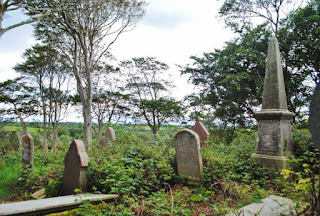Rappa Castle
Crossmolina, Co. Mayo
&
The Mias Tighearnain
 |
| The Mias Tighearnáin |
Many times when in Dublin Rappa Castle Rappa Castle
 |
| Rappa Castle as it was in the 19th Century, the home of the Knox Family found near Crossmolina, Co. Mayo. Copyright: ICHC |
The Mias Tighearnáin, an alms dish, was said to have
been dug out of the grave of St. Tiernan near Errew Abbey beside Lough Conn Lough Conn Rappa Castle county Mayo and 724 acres in county Galway
In “ A Guide to Irish Country House”, Rappa Castle located
near Crossmolina in Co. Mayo is described as an early or mid-eighteenth
century house consisting of a three storey centre block of four bays with two
storey wings on either side. The centre block and the side wings also had high
pitched gable ended roofs, with tall chimneys in the gable ends. The castle was
once home to the Crofton family with a castle being built on the site in the
fifteenth century by the Burke family. It eventually came in to the ownership
of a gentleman by the name of Francis Knox who was resident in the castle in
1798 and previously in 1786 the house was mentioned as being ‘the pleasant seat
of Mr. Knox’. Francis Knox was the third son of Francis Knox of Moyne Abbey and
Dorothy Annesley. Francis died in 1813 having married and produced six sons and
six daughters. He was succeeded by his eldest son Annesley Gore Knox who died
in 1839. He had married Harriett in 1793 who was the sister of Sir Ross Mahon.
Harriett and Annesley had eight sons and five daughters. The eldest
surviving son inherited Rappa, also named Annesley was succeeded by his son
Captain Annesley Arthur Knox.
 |
| William Robert Wilde, the father of Oscar Wilde, whom took an interest in the Mias Thighernain. |
In 1882, a visitor to the castle found
the Mias Tighearnáin in the procession of Captain Annesley
Arthur Knox. They give the following description of their visit and the
relic ‘The owner of Rappa Castle Lough Conn
 |
| The gate lodge and entrance gates to Rappa Castle which survive today. Copyright: ICHC |
In 1897, Captain Knox died and his estate,
castle and contents passed to his nephew Ronald Annesley Knox who was only a
six year old child at the time. Captain Knox had a brother Ross, the father of
Ronald, but he was by passed in favour of his son. Captain Knox’s will
was probated in Dublin Ireland if he
would make inquiry as to the possibility of procuring it for the National Museum in Dublin Rappa Castle Rappa Castle Rappa Castle Cork Cork Rappa Castle Rappa Castle Rappa Castle Rappa Castle Rappa Castle
 |
| Rappa Castle in ruins today after it was dismantled in the 1930'sCopyright: ICHC |
In January 1925, Violet Knox, (Ross's widow), married
Thomas Dodd Lowther of Queen Ann’s Mansions Westminster London. It is obvious
that she took the Mias with her to England as
it later appeared for sale in London London London and
formerly of Glasgow and late of
Castlerea and Rappa Castle, Co. Mayo, wife of Thomas Dodd Lowther died and left
a personal estate in Britain Rappa Castle Mount Stewart , Rothesay, Isle of Bute in Scotland Museum of Country Life
